4 One-on-ones you need to add to your calendar
Brennan McEachran, CEO and Co-founder of Hypercontext, and revenue leader, Jocelyn Brown recently shared their wisdom on 4 different types of one-on-ones and why you need them in your calendar. Want an overview? Read on!
Warning: Undefined array key "category" in /www/hypercontext_216/public/wp-content/themes/Soapbox/hype-files/sections/article/content.php on line 10
Why are one-on-ones the best tool in a manager’s toolkit? 🛠
Last month, Brennan McEachran, CEO and Co-founder of Hypercontext and Jocelyn Brown, former SVP of Customers and Revenue, ran a webinar that delved into 4 different types of one-on-ones and how you can leverage them to become a better manager and employee.
If you couldn’t make it to the chat, don’t worry. In this article, we review their conversation and look at the purpose, best practices and try-it-tomorrow tips for:
- One-on-ones with your direct reports
- One-on-ones with your manager
- Skip level meetings
- Peer-to-peer meetings
1:1s with direct reports
Every manager wants to be trusted by their team (we hope!). Conducting one-on-ones with your direct reports are one of the best ways to build that foundation. But that’s only the beginning.
The purpose of one-on-ones with direct reports
At a very basic level, your one-on-ones with employees are a routine cadence to discuss growth, work, motivation, challenges, etc. They’re a dedicated space you can rely on to build rapport and trust, and share news, feelings and frustrations.
But they go beyond that too. Jocelyn explains that during her time as SVP Customer Sales and Revenue, she stuck with 1:1s for two major reasons:
- Having a consistent touch base with your direct report helps ensure you’re aligned on messaging. They’re probably in a lot of rooms that you’re not. Ensuring they’re on the same page as you helps make your messaging more consistent throughout the entire organization.
- Your one-on-one with your direct report is a time to learn. The higher up you get, the further away you become from more practical knowledge and on-the-ground problems. For example, if you’re a sales executive, you’re likely getting increasingly further away from what the customers are actually saying. It’s important to consistently talk to those who are closer to the problems (aka your team).
Your one-on-ones with employees help better connect you not only with your respective direct reports, but with the entire company.
Best practices for 1:1s with direct reports
Here are a couple of best practices to keep in mind to make the most out of your dedicated time with employees:
- Consistency: Keep your meeting the same day and time each week (or however often you do your one-on-ones). That way your direct reports know they can rely on the meeting and focus more on how to show up and meaningfully participate.
Tip: While it’s great to meet with each of your direct reports for an hour each week, that’s not always doable! Especially for those with many direct reports — the hours can start to add up. Choose a duration that you can reliably follow-through on.
- High safety, low effort, high benefit: What does this mean? Let’s break it down:
High safety: In a study by Google, psychological safety is cited as the highest leading indicator of team performance. And your one-on-ones are the single highest psychologically safe moment for your team. They should be able to bring up anything they want to discuss without fear.
Low effort: Sharing feedback in your one-on-ones should be low effort for your direct reports. If it feels like they’re preparing for their PhD dissertation every time they give you feedback, something’s wrong.
High benefit: If you don’t act on feedback, you’re likely a low benefit manager. And, at a certain point, your team will stop coming to you with concerns because they believe that there’s no point. Make sure you take feedback seriously so your employee can see the benefit of sharing.
- The direct report owns the meeting: Remember that this is your direct report’s meeting. When you’re onboarding someone it makes sense to start with a 10/10/10 model. That is,10 minutes lead by the direct report, 10 minutes lead by the manager and 10 minutes dedicated to the future. But the ultimate goal should be a hands-off model, where your direct report is in full control of the meeting. Make it explicit to your team what format you’re following so they know how to prepare.
💡 Try-it-tomorrow tip: The lettuce pact. The lettuce pact is an easy hack to encourage feedback sharing on your team. Brennan explains below:
1:1s with managers
When we asked webinar attendees what types of one-on-ones they’re currently having, 1:1s with managers were cited as the most common.
The purpose of one-on-ones with managers
From a direct report’s perspective, one-on-ones are the best opportunity to grow and manage up.
Why?
It’s in your manager’s best interest to know how you’re doing. They want to retain you. Recruiting is a time-intensive and expensive process. In fact, it can cost up to 150% of your yearly salary to replace you.
But here’s the thing: managers can’t read your mind. If you can tell them how you want to grow and help them focus on what’s important for you, it’s actually a gift for them. After all, part of their job is retaining a high-performing team.
Not to mention the benefits for you as an employee. When your manager has an understanding of what you’re looking for in your work and career, it’ll help make your goals easier to achieve.
Best practices for one-on-ones with your manager
- Set expectations: Just because your manager schedules the 1:1 doesn’t mean it’s their meeting. When you set expectations, it’ll help them come to the meeting prepared. A great place to set expectations? The agenda description. What are you hoping to get out of your time together?
- Drive the meeting: Add items to the agenda so it’s clear what you want to talk about in the meeting. Your manager can move things around if they need to but at least they have a record of what’s top of mind for you.
Psst 🤫: Need help thinking of what to ask? Check out this round-up of 121 one-on-one questions or choose from 100s of conversation starters in-app.
- Give and ask for feedback- When it comes to feedback sharing, be specific in the type of feedback you’re looking for — this makes it easier for your manager to give you practical advice. When your manager does give you feedback, write it down so you can review and remember it. Show that you take constructive feedback seriously and act on it to help build trust and demonstrate your commitment to growth.
💡 Try-it-tomorrow-tip: If you’re the direct report in a one-on-one meeting, take over ownership of the meeting agenda. This includes holding your manager accountable for what they commit to.
Manager/direct report one-on-one agenda template
Whether you’re a manager or a direct report, here are some examples of questions to add to your one-on-one meeting agenda:
- What has been the highlight and lowlight of your past week
- Goals- how are you tracking this past week? Any blockers I can help remove?
- What, if anything, feels harder than it should be in your day to day work?
- If there was one thing I could do differently to help you more, what would it be?
- On a scale of 1-10 how happy are you with your work life balance? How can we get closer to 10?
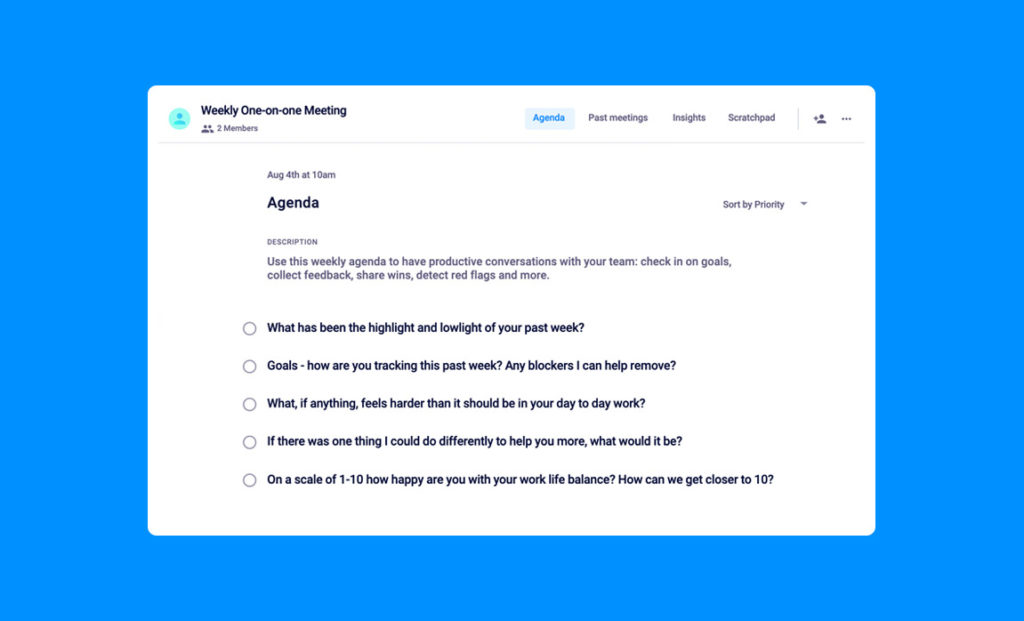
Skip-level meetings
Skip-level meetings connect employees with leadership — an important opportunity for both parties.
The purpose of skip-level meetings
Skip-level meetings are a great chance for the team to empathize with leaders and vice versa. This is especially true on a remote team when there may not be as much visibility day-to-day.
For employees skip levels are an opportunity to ask as many questions as you can about things you don’t know. Use this time to gain more insight into your company.
For leaders this is a fact-finding mission. According to the iceberg of ignorance theory, executives only see 4% of the problems that exist within an organization. Employees, on the other hand, see it all. Skip level meetings are a time to lower the waterline and expose some problems leaders may not know about.
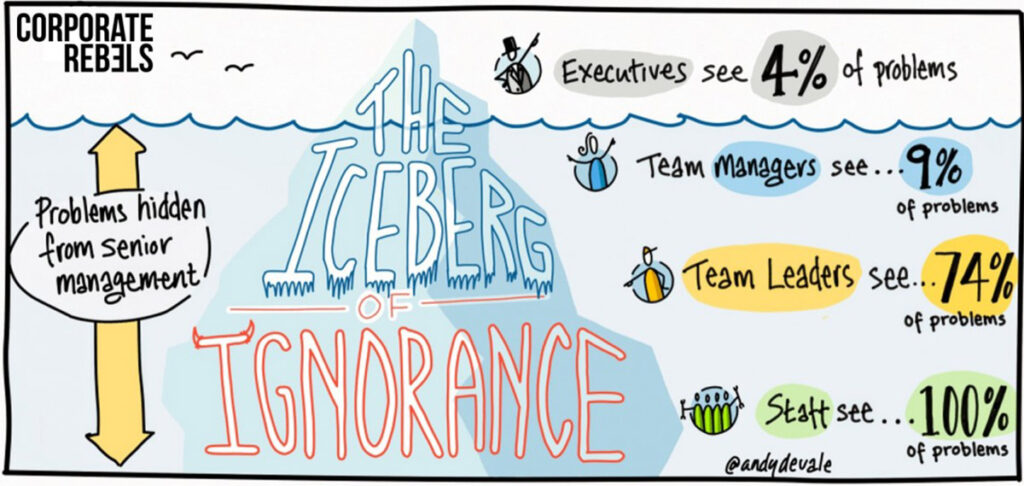
Skip levels are also a great way to uncover if there’s any broken telephone going on. Think about it: most of the time you’re communicating directly with your manager or team member and the messages get passed on. This is an opportunity to speak directly with the source to get a better understanding of any potential miscommunications.
💡 Try-it-tomorrow tip: You likely aren’t already having skip-level meetings. Try booking one. If it’s coming out of nowhere, make sure you explain it! Don’t just put 30 minutes in someone’s calendar — that’ll freak them out. Communicate the purpose of the meeting to avoid sounding off alarms.
Skip-level one-on-one agenda template
Here are some examples of questions to add to your skip-level meeting agenda:
- What are you LEAST clear about — in terms of our strategy and goals?
- What professional goals would you like to accomplish in the next six to 12 months and what makes you say that?
- Are you happy in your role? What could make it better for you?
- What’s one thing we should start, stop and continue doing as a company?
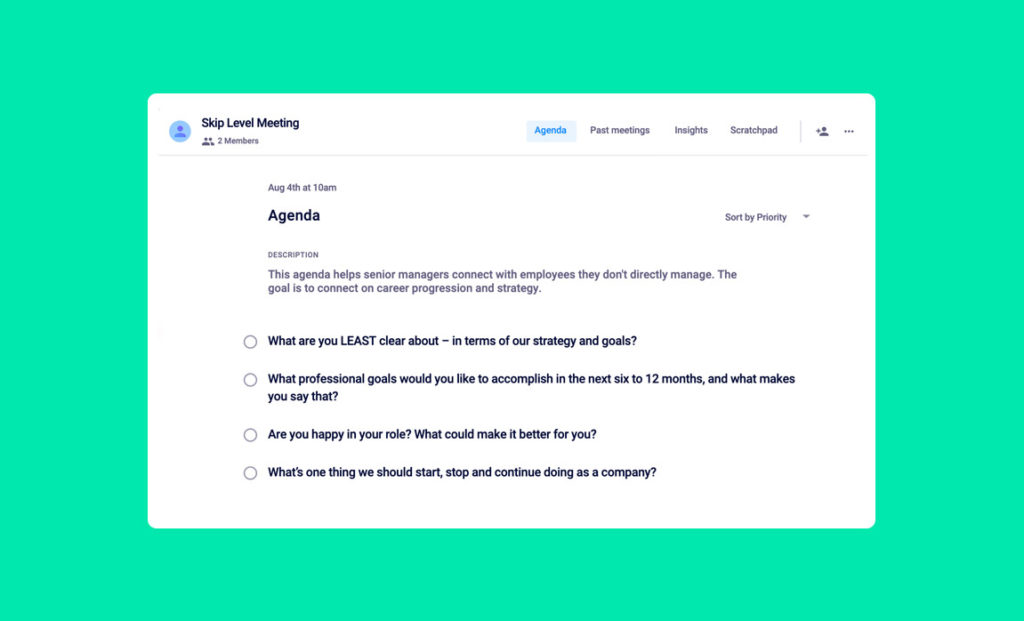
Peer-to-peer meetings
There’s immense value in lateral 1:1s with peers, but a lot of people aren’t having them. Here’s an overview of why you may want to consider meeting with your colleagues more regularly.
The purpose of peer-to-peer meetings
One-on-ones with your peers allow you to connect with a whole new network of people who are potentially going through the same challenges as you are. Open up communication lines and put your brains together to tackle common issues. They may have figured out things that you haven’t yet— like how to navigate office politics or work with a difficult manager.
Peer-to-peer meetings also lessen finger-pointing. It’s easy to put the blame for a project gone wrong onto another team. But, if you’re connecting with your peers, you can better understand blockers and limitations and have greater context to decisions being made on their team. This will increase empathy and improve cross-functional collaboration.
💡Try-it-tomorrow-tip: Prioritize. You likely have a lot of peers, so don’t over-commit to meeting with all of them regularly. Start by meeting with those who are closest to you in the business. It’s okay to meet with those further away from you less frequently.
Peer-to-peer one-on-one agenda template
Here are some examples of questions to add to your peer-to-peer meeting agenda:
- What’s one thing I can do to make your job easier?
- What’s the biggest challenge you and your team are facing?
- What’s something me or my team can do to improve cross-departmental communication?
- What’s coming down the piepline in the next 3 months that I should know about?
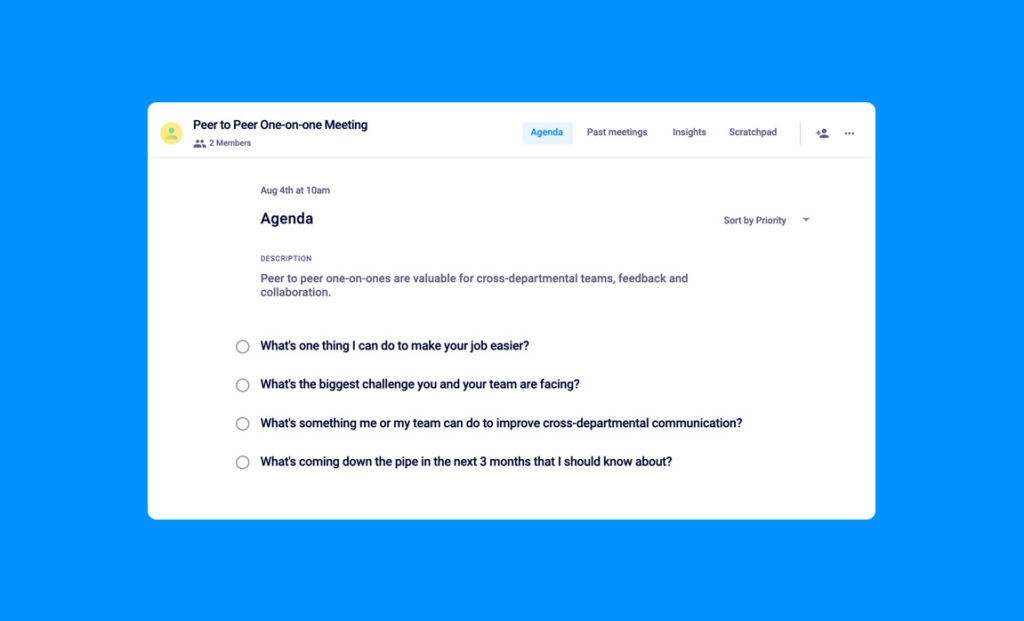
Adding one-on-ones to your calendar
If these 4 types of one-on-ones aren’t already in your calendar, now’s the time to add them!
By taking the time to meet with your direct reports, manager, senior leadership and peers you’ll gain a new level of visibility and understanding of your organization as a whole and build empathy and trust with the people you work with every day.
Interested in learning more about the benefits of these one-on-ones from Brennan and Jocelyn themselves? Check out the webinar here:
Even better? Talk to Brennan or Jocelyn directly about how to improve your meetings by booking a free meeting tune-up ✨
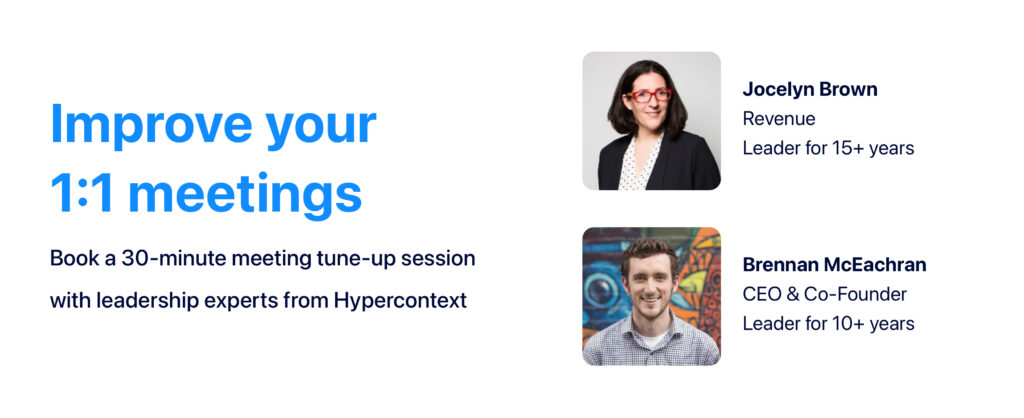
What you should do now
Now that you've read this article, here are some things you should do:
- I think you will love our library of meeting agenda templates for every type of meeting.
- You should try Spinach to see how it can help you run a high performing org.
- If you found this article helpful, please share it with others on Linkedin or X (Twitter)
